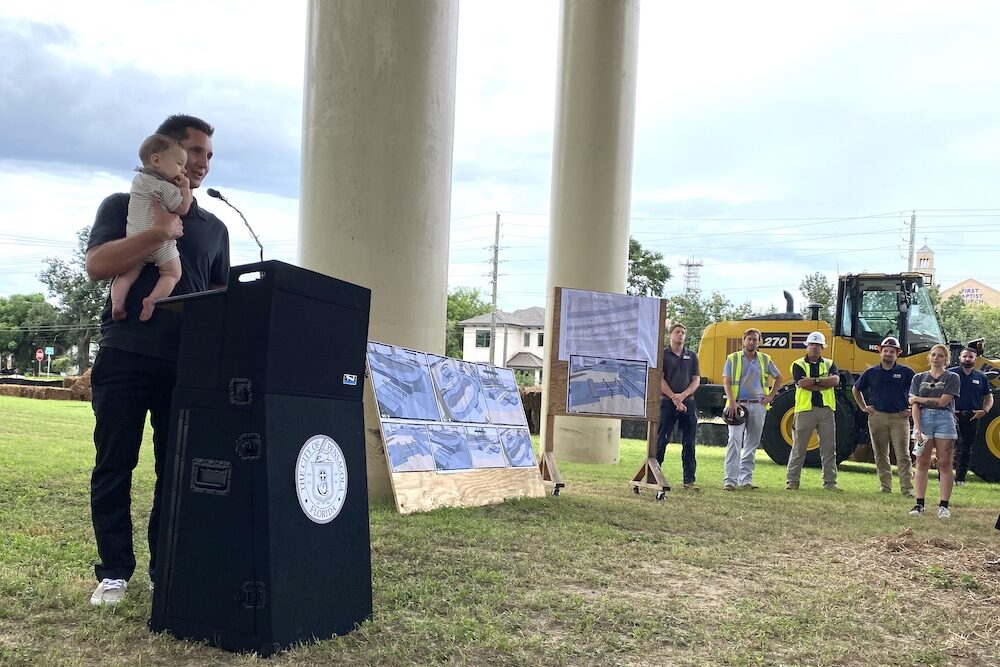By Jeremy Morrison
Beneath spans of Interstate-110 Tuesday, the city of Pensacola officially broke ground on the Blake Doyle Skatepark.
“Sometimes people are asking me, where’s it going to be?” Pensacola Mayor Grover Robinson told a crowd assembled for the occasion. “It’s gonna be big. It’s going to be under that section and it’s going to be under this section.”
This skatepark is a municipal project years in the making, with official discussions beginning in 2015. A public skatepark, however, is something that the Pensacola skateboarding community has been seeking for years.
“I remember back in the 1990s when my kids were skateboarding — you know, we would go down Gregory and Palafox and we kept saying we need a skatepark, and that was, what, 30 years ago,” recalled Pensacola City Council President Ann Hill. “So, it’s been a long wait.”
The city’s skatepark is part of a larger Escambia County project, the Hollice T. Williams Park, a greenway paid for with RESTORE funds, which stem from environmental penalties associated with the 2010 Deepwater Horizon oil spill in the Gulf of Mexico. The skatepark itself, expected to be completed by next summer, costs approximately $2 million and is funded through a collection of private and public sources.
Some of the funds going into the skatepark were secured by Upward Intuition, a non-profit started by skateboarder Jon Shell. He originally pitched the concept of a public skatepark to the city. Shell spoke Tuesday about how kids involved in Upward Intuition, an organization geared toward inspiring confidence in youth with a focus on skating, have grown up watching their efforts bear fruit.
“They were around 7 or 8 when we started,” Shell said, explaining how the group helped raise money and garner support for the park. “These kids went door to door. They asked for skatepark donations instead of birthday gifts. They spoke at city council meetings. They washed cars. All to make today possible.”
Holding his baby in his arms as he spoke, Shell said he felt he had also experienced considerable growth during the years that have transpired since he first pitched the skatepark. His push for the park was born within a valley of his life.
“I was actually kind of in a low place,” Shell said. “My life didn’t have much direction, and I just kind of felt like I was coming to a crossroads.”
The luster of a life where Shell was “having as much fun as I possibly could…“surfing, skating, going to parties” was wearing thin. After waking up on New Year’s Day 2015 with a morning-after headache, the skater said he began praying, hoping that he could find a more meaningful path.
“And find some kind of purpose or direction,” Shell recalled, “that would kind of guide, you know, the next chapter of my life.”
The skateboarder’s thoughts turned to youth who, like himself, grew up feeling like outsiders because the community did not embrace the sport they enjoyed.
“These were the kids who had maybe lost interest in team sports,” Shell said. “These are the kids that get the cops called for skating on private property; these are the kids that some people might call outcasts. So, I kind of coined this demographic: ‘the forgotten youth.’ And really started kind of dreaming and visualizing and writing about a space for them and what it might look like and the problems I believed it would address.”
That same month, Shell’s friend, fellow skater Blake Doyle, was killed when he was struck by a train. After consulting with Doyle’s twin brother, Bart, a decision was made to name the skatepark Shell had begun pushing for after the lost skater.
“Once we decided this was for Blake, I kind of felt like there was no turning back, and it was kind of like a sink or swim type thing,” Shell said.
While Shell found a fairly receptive audience from the get-go, the journey to realizing the skatepark was not without challenges. Funding for the project was a heavy lift, and while plenty of money was contributed from private sources, more public funds were ultimately tapped than initially expected. Additionally, the project required partnership and coordination between multiple governmental agencies, and also weathered the hurdles imposed by the coronavirus pandemic.
Considering these challenges encountered, Shell said he hoped the experience, and the park itself, could prove valuable fo the city’s youth.
“My hope and prayer for once this park is built, is that it will offer the next generation — because I see a lot of them out here right now — what it has already given me, a place where they can learn to overcome obstacles, have something to work on, work towards, feel encouraged and supported and just to have a place where they feel like they belong without getting the cops called on them,” Shell said.
